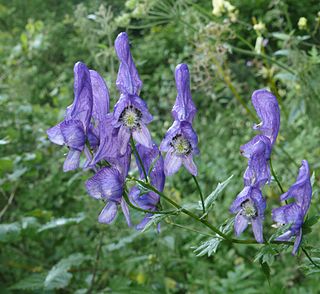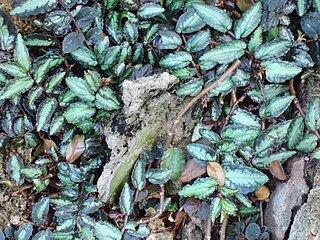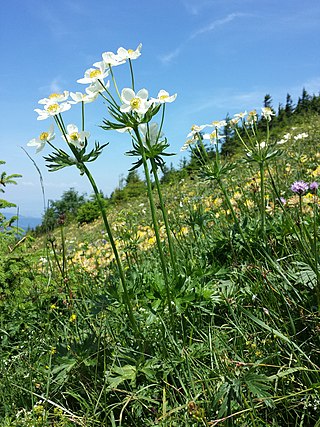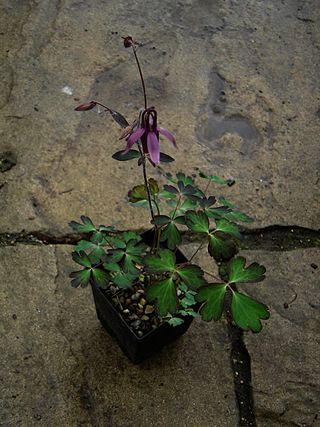
Aconitum, also known as aconite, monkshood, wolfsbane, leopard's bane, devil's helmet, or blue rocket, is a genus of over 250 species of flowering plants belonging to the family Ranunculaceae. These herbaceous perennial plants are chiefly native to the mountainous parts of the Northern Hemisphere in North America, Europe, and Asia, growing in the moisture-retentive but well-draining soils of mountain meadows.

Anemone is a genus of flowering plants in the buttercup family Ranunculaceae. Plants of the genus are commonly called windflowers. They are native to the temperate and subtropical regions of all regions except Australia, New Zealand, and Antarctica. The genus is closely related to several other genera including Anemonoides, Anemonastrum, Hepatica, and Pulsatilla. Some botanists include these genera within Anemone.

Ranunculales is an order of flowering plants. Of necessity it contains the family Ranunculaceae, the buttercup family, because the name of the order is based on the name of a genus in that family. Ranunculales belongs to a paraphyletic group known as the basal eudicots. It is the most basal clade in this group; in other words, it is sister to the remaining eudicots. Widely known members include poppies, barberries, hellebores, and buttercups.

Ranunculaceae is a family of over 2,000 known species of flowering plants in 43 genera, distributed worldwide.

The genus Pulsatilla contains about 40 species of herbaceous perennial plants native to meadows and prairies of North America, Europe, and Asia. Common names include pasque flower, wind flower, prairie crocus, Easter flower, and meadow anemone. Several species are valued ornamentals because of their finely-dissected leaves, solitary bell-shaped flowers, and plumed seed heads. The showy part of the flower consists of sepals, not petals.

Actaea, commonly called baneberry, bugbane and cohosh, is a genus of flowering plants of the family Ranunculaceae, native to subtropical, temperate and subarctic regions of Europe, Asia and North America.

Potyviridae is a family of positive-strand RNA viruses that encompasses more than 30% of known plant viruses, many of which are of great agricultural significance. The family has 12 genera and 235 species, three of which are unassigned to a genus.

Glaucidium is a genus of plants in family Ranunculaceae, comprising a single species Glaucidium palmatum. It is endemic to northern and eastern Japan on Hokkaidō and northeastern Honshū on mountains close to the Sea of Japan.

Pellionia is a genus of flowering plants in the family Urticaceae. The flowers of Pellionia are white globules held on stalks above the plant, which respond to changes in temperature by releasing their pollen as little puffs of smoke.

Eriocapitella hupehensis, a species of flowering plant in the buttercup family Ranunculaceae, is native to Asia. The specific epithet hupehensis, which means "from Hupeh province, China", refers to a region where the species is known to occur. In Chinese, it is called dǎ pò wǎn huā huā (打破碗花花), which means "broken bowl flower".

Anemonastrum is a genus of flowering plants in the family Ranunculaceae. Plants of the genus are native to the temperate and subarctic regions of North America, Greenland, Europe, Asia, South America, and New Zealand. The generic name Anemonastrum means "somewhat like anemone", a reference to the Anemone genus of closely related plants. It chiefly differs from Anemone in having a base chromosome number of x=7, as opposed to x=8.

Hemiboea is a genus of flowering plants belonging to the family Gesneriaceae.
Litostigma is a genus of flowering plants belonging to the family Gesneriaceae.

Metapetrocosmea is a genus of flowering plants belonging to the family Gesneriaceae. It includes ten species native to southern China, Hainan, and Vietnam.

Leptopyrum is a monotypic genus of flowering plants belonging to the family Ranunculaceae. The only species is Leptopyrum fumarioides, native to north and east Asia.

Aquilegia rockii is a perennial flowering plant in the family Ranunculaceae, native to southern China.

Delphinieae is a tribe of the subfamily Ranunculoideae of the family Ranunculaceae. It comprises 4 genera found in Eurasia, North America, and Africa.
Diceros gansuensis is an extinct species of Diceros that lived in China during the Late Miocene.

Aquilegia amurensis is a partially accepted species of flowering plant in the genus Aquilegia (columbines) in the family Ranunculaceae that is native to the northeastern Asian. Its natural range is in the northern Greater Khingan mountain range and Amur River of China, as well as Siberian Russia, Mongolia, and possibly North Korea. Flowers of this plant have petal blades that are whitish or white-tipped, with blue-violet nectar spurs and sepals. The plant is rarely cultivated.
Aquilegia grubovii is a perennial flowering plant in the family Ranunculaceae, native to northern Mongolia and Tuva in Russia.
















